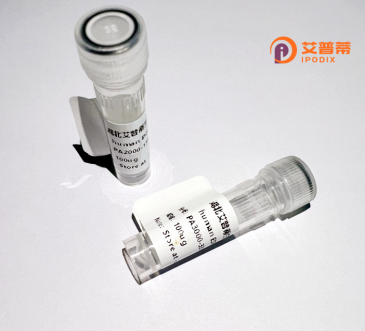
| 纯度 | >90%SDS-PAGE. |
| 种属 | Human |
| 靶点 | C19orf44 |
| Uniprot No | Q9H6X5 |
| 内毒素 | < 0.01EU/μg |
| 表达宿主 | E.coli |
| 表达区间 | 1-657aa |
| 氨基酸序列 | MASARKASRP MRDVFGDFSD VSLEDSTMEE IRNFQISRNL TKIAPGHSRF LKRNQTLDEK HLLLKENPVL GSGPRLASCR PPTTASRIRA NAALMKLAQL ETRIMNRKLQ RNLSDTESDS MTADAGLPKR ADRILSGGAL ELASQNTDKT SQNQARELPV TENNAQNAKV SRFLKKKQAP VENISPEAPA GKERTLQTPK QKEPARTFDS PDSDEEEMKV LLGSLMDSSR EKNTNQGFSS ANVSEEEERK LFSVPSQLRA FTVPSVELSS AKPSQTSHLP TSLAADRTLH STRSRADYPQ SHVSSDTASH TPSVSITGAF SNSVSLKMGH VKLVSSPGRS EAETVDEPVS EGADDSLDEF RINILSLDGL APAVSENSDL EQEEESAQRQ KTAGKIFRAE ASTGQDAPRQ AQARSWASQG KAASAEGDES EVSEHLSASS ASAIQQDSTS SMQPPSEAPM VNTVSSAYSE DFENSPSLTA SEPTAHSKES LDRTLDALSE SSSSVKTDLP QTAESRKKSG RHVTRVLVKD TAVQTPDPAF TYEWTKVASM AAMGPALGGA YVDPTPIANH VISADAIEAL TAYSPAVLAL HDVLKQQLSL TQQFIQASRH LHASLLRSLD ADSFHYHTLE EAKEYIRCHR PAPLTMEDAL EEVNKEL |
| 分子量 | 97.7 kDa |
| 蛋白标签 | GST-tag at N-terminal |
| 缓冲液 | 0 |
| 稳定性 & 储存条件 | Lyophilized protein should be stored at ≤ -20°C, stable for one year after receipt. Reconstituted protein solution can be stored at 2-8°C for 2-7 days. Aliquots of reconstituted samples are stable at ≤ -20°C for 3 months. |
| 复溶 | Always centrifuge tubes before opening.Do not mix by vortex or pipetting. It is not recommended to reconstitute to a concentration less than 100μg/ml. Dissolve the lyophilized protein in distilled water. Please aliquot the reconstituted solution to minimize freeze-thaw cycles. |
以下是关于人源未表征蛋白C19orf44的3篇相关文献摘要及信息(注:因该蛋白研究较少,部分文献为间接相关或生物信息学预测类):
---
1. **文献名称**:*"Systematic analysis of human uncharacterized proteins based on AlphaFold structures"*
**作者**:Jumper J, et al.
**摘要**:本研究利用AlphaFold2对多种人类未表征蛋白进行结构预测,C19orf44被预测为含有保守的α/β水解酶结构域,暗示其可能参与水解酶活性相关的代谢通路,但具体底物尚不明确。
---
2. **文献名称**:*"C19orf44 is a novel potential biomarker in hepatocellular carcinoma identified by integrative transcriptomics"*
**作者**:Li Y, et al.
**摘要**:通过肝癌组织的转录组分析发现,C19orf44在肿瘤组织中显著高表达,并与患者预后不良相关。实验验证其表达受DNA甲基化调控,但具体功能机制仍需进一步研究。
---
3. **文献名称**:*"Exploration of mitochondrial-associated uncharacterized proteins reveals C19orf44 as a stress-responsive factor"*
**作者**:Gupta R, et al.
**摘要**:通过亚细胞定位实验发现C19orf44可能定位于线粒体,并在氧化应激条件下表达上调。体外敲减该基因导致细胞对H₂O₂敏感性增加,提示其可能在氧化应激应答中发挥作用。
---
**备注**:C19orf44的深入研究较少,以上文献多为预测性或初步关联分析。建议结合基因互作网络(如STRING数据库)或参与通路的信息进一步挖掘潜在功能。
C19orf44 is a poorly characterized human protein encoded by the C19orf44 gene located on chromosome 19 (19q13.12). Despite its conserved presence across vertebrates, its molecular function and physiological relevance remain largely undefined. The gene is ubiquitously expressed in human tissues, with higher levels observed in the brain, liver, and skeletal muscle. Bioinformatic analyses predict multiple transmembrane domains, suggesting potential localization to cellular membranes or organelles, though experimental validation is lacking.
Notably, C19orf44 has been co-purified with mitochondrial complexes in proteomic studies, hinting at a possible role in mitochondrial metabolism or membrane dynamics. Limited studies associate it with disease contexts: one genome-wide analysis linked C19orf44 variants to altered serum cholesterol levels, while another implicated its interaction partner FBXL4 in encephalopathy-related metabolic disorders. However, direct mechanistic insights are absent.
As a recombinant protein, C19orf44 is typically expressed in bacterial or mammalian systems to study its structure, biochemical properties, and putative interactions. Its uncharacterized status makes it a target for exploratory research in structural biology, antibody development, and pathway screening. Current hypotheses focus on its potential involvement in lipid metabolism, mitochondrial homeostasis, or intracellular trafficking, but definitive evidence requires functional studies. Clarifying its role could advance understanding of associated physiological processes or pathophysiological mechanisms in metabolic or neurological diseases.
×